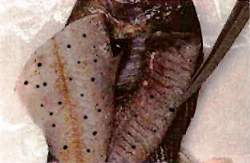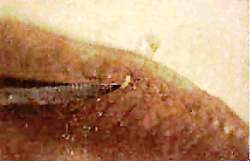Occasionally, anglers catch
a fish infested with parasites. A healthy fish can tolerate some parasites with
little ill effects. Black spot and yellow grub are the most common parasites found
in Iowa pond fish. Fish infested with yellow grub are often called "wormy"
or "grubby". This parasite is found in largemouth bass and bluegill.
The yellow grub is enclosed in a cyst which often lies just beneath the skin. A
bulge is often seen at the base of the fins or tail. The living worm, when
squeezed from this bulge, is light yellow and about 1/4 inch long and 1/20 inch
wide.
Black spot is small, black grains
embedded in the skin and flesh. These black spots are the home to a small
fluke. Found on several species of fish, they are very common on bluegill.

Black spot in fish fillets
|

Yellow grubs in fish fillets
|
Since
humans cannot be infected with these parasites, it is safe to eat fish that
have them. The parasites are killed when the fish are thoroughly cooked. It is
not practical to try to remove these parasites from a pond.
A fungus called Saprolegnia can sometimes be found on fish in ponds. This grayish, cotton-like growth is usually a secondary infection caused by an adverse environmental condition such as disease, low oxygen levels or spawning stress. Many times it is seen on the tails, sides or bellies of fish which have rubbed these areas raw while spawning. Fish not too badly affected will recover, but some will die.